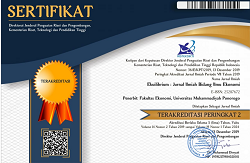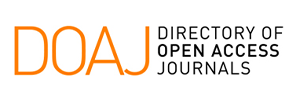Discriminant Study with Classification of Underdeveloped and Developing City Districts in West Papua Province
DOI: 10.24269/ekuilibrium.v15i2.2020.pp103-117
Abstract
This study aims to determine whether there are clear differences between groups on the dependent variable. This analysis uses the independent variable Life Expectancy (X1), Number of Health Facilities (Puskesmas) (X2), Number of Facilities (Supporting Puskesmas) (X3), Polindes Facilities (X4), percentage of households that do not use electricity (X5). The dependent variable is the regencies / cities lagging behind and developing in West Papua. The research sample uses secondary data, which are the results of the 2017 National Socio-Economic Survey (SUSENAS) conducted by the West Papua Statistics Agency (BPS). The discriminatory method is to test the difference between the stipulation of disadvantaged districts / cities and the stipulation of a Presidential Decree. 131 of 2015, concerning disadvantaged districts / cities in West Papua with normality test data. The object applied is all districts / cities in West Papua. Discriminant analysis can separate lagging and developing districts / cities in West Papua province by calculating function scores by comparing with interrupted scores, the results of the study are 5 districts / cities classified as disadvantaged districts and 6 districts / cities classified as developing districts/city. the influencing factor is facilities (village polyclinic) and the percentage of households that do not use electricity with a percentage decision 100%, theoretical evidence that the five variables prove that the discriminant analysis method shows the same results as the results issued by the Presidential Decree. 131 of 2015 with the percentage of decisions is 100%.
Keywords
Multivariate Analysis, Discriminant Analysis, Discriminant Score
References
- Afianti, Sonya Kurniasari, D. (2014). Village Office Separation in Semarang Regency According to Regional Status Using Classic Quadratic Discriminant Analysis and Robust Quadratic Discriminant. Classical Quadratic and Discriminant Quadratic Robust,. Jurnal Gaussian,Volume 3,Nomor 1., 1-10.
- Ahmad, S. Harris T, L. E. (2015). Evaluation of reliability and validity of the General Practice Physical Activity Questionnaire (GPPAQ) in 60–74 year old primary care patients. London: BMC Family Practice.
- Bappenas. (2006). Tata cara Perencanaan Pengembangan Kawasan Untuk Percepatan Pembangunan Daerah.Direktorat Pengembangan Kawasan Khusus dan Tertinggal. Jakarta: Bappenas. http://pu.net.
- BPS, Papua Barat. (2017, Desember 31). Sosial dan Kependdudukan. Manokwari, Papua Barat, Indonesia.
- Government, Republik Indonesia. (2015). Presidential Regulation Number 131 Year 2015. Jakarta: Ministry of Law and Human Rights Republic of Indonesia.
- Haggett, P. (2001). Geography, A Global Synthesis. London: Prentice Hall.
- Hartono, J. (2007). Hartono, Jogiyanto. (2007). Metodologi Penelitian Bisnis: Salah Kaprah dan Pengalaman-Pengalaman. Edisi 2007. Yogyakarta : BPFE.
- Ida, Ayu Made Supartini, I. I. (2017). Discriminant Analysis of Village Classification in Tabanan District Using the K-Fold Method. E-Jurnal Matematika Vol. 6 (2), 106-115.
- Jayadinata, J. (1992). Pembangunan Desa dalam perencanaan . Bandung: ITB.
- Kuncoro.Mudrajad. (2000). Ekonomi Pembangunan: Teori, Masalah dan Kebijakan. Yogjakarta: UPP AMP YKPN.
- Kunjana, G. (2018). Fighting Discrimination in Urban Development. Jakarta: Investor.id.
- Lendi, Ageng Kurnia, D. (2019). Determinants Self Sufficiency Of Rice In Supporting Food Independence. Ekuilibrium : Jurnal Ilmiah Bidang Ilmu Ekonomi Vol. 14 No 2 , 152-166.
- Lincolin, A. (2010). Economic development. Yogyakarta: UPP STIM YKPN.
- Minister, Republik.Indonesia. (2016). Regulation of the Minister of Villages Underdeveloped Development. Jakarta: Ministry of Villages Underdeveloped Development.
- Muhtar. (2011). Village Community: Needs, Problems, Assets and the Concept of Empowerment Model. Journal of Social Welfare Research and Development, Vol. 16 No. 01, 17-34.
- Nazir, Moch. (2011). Mold Research Methods 6. Bogor: Ghalia Indonesia.
- Rosmeli, Nurhayani. (2014). Comparative Study of Regional Inequality Between Western Indonesia and Eastern Indonesia. Mankeu, Vol.3 No.1,, 374-463.
- Saifullah. (2006). Metodologi Penelitian. Malang: UIN Malang.
- Santoso, S. (2010). Mastering SPSS 18. Jakarta: PT Elex Media Komputindo.
- Satria, Wiratama, H. (2018). Development Analysis of Underdeveloped Regions in East Java Province. eJournal of Business Economics and Accounting Volume V (1), 16-20.
- Situmorang, Syafrizal Helmi, D. M. (2008). Analisis Data Penelitian (Menggunakan Program SPSS). Medan: USU Press.
- Sugiyono. (2014). Educational Research Methods Quantitative, Qualitative and R&D Approaches. Bandung: Alfabeta.
- Unggul, P. (2017). Identification of Growth Centers and Hinterland Areas in the Special Province of Yogyakarta. AJIE - Asian Journal of Innovation and Entrepreneurship, 193-219.
- Wibowo, A. R. (2019). Analysis Of Determinants Of Poor Population. Ekuilibrium : Jurnal Ilmiah Bidang Ilmu Ekonomi Vol. 14 No 1, 1-15.
- Widarjono, A. (2010). Applied Multivariate Statistics Analysis. Yogyakarta: UPP STIM YKPN.
- Yunita, Niken Widya. (2015). Jokowi Establishes 122 Regencies of Disadvantaged Regions 2015-2019. Jakarta: News, Detik.com.
Refbacks
- There are currently no refbacks.

This work is licensed under a Creative Commons Attribution-ShareAlike 4.0 International License.















